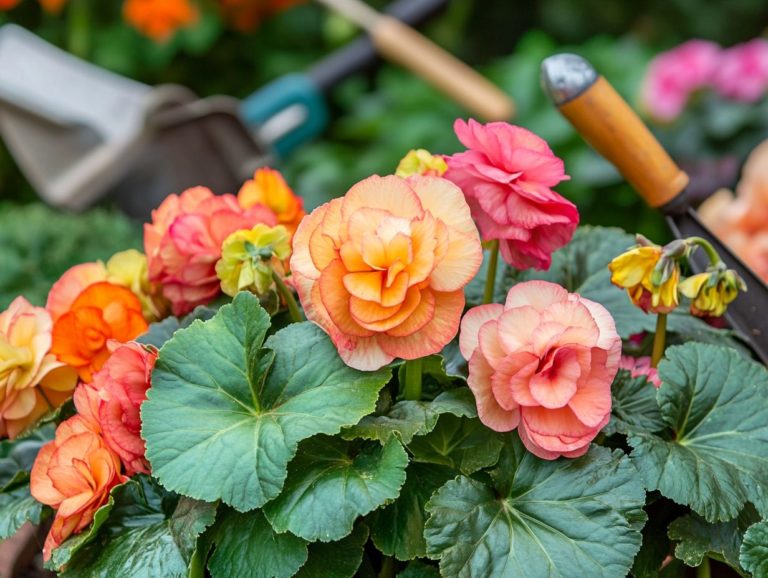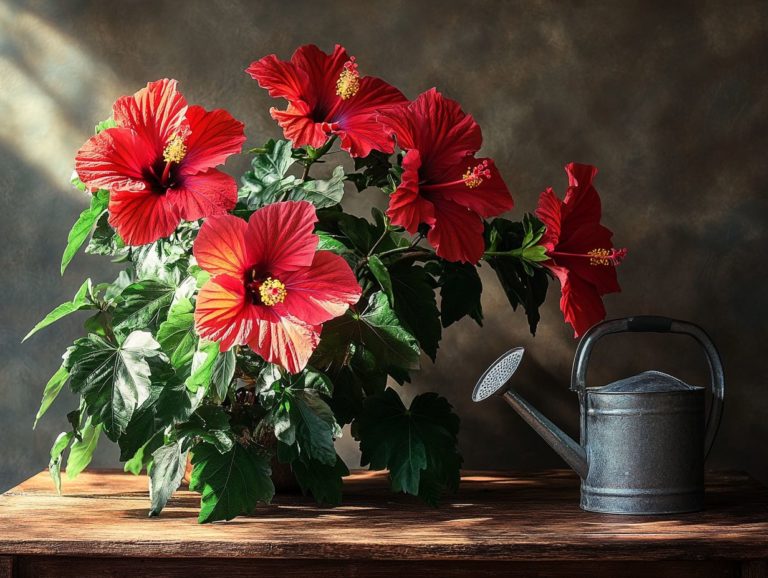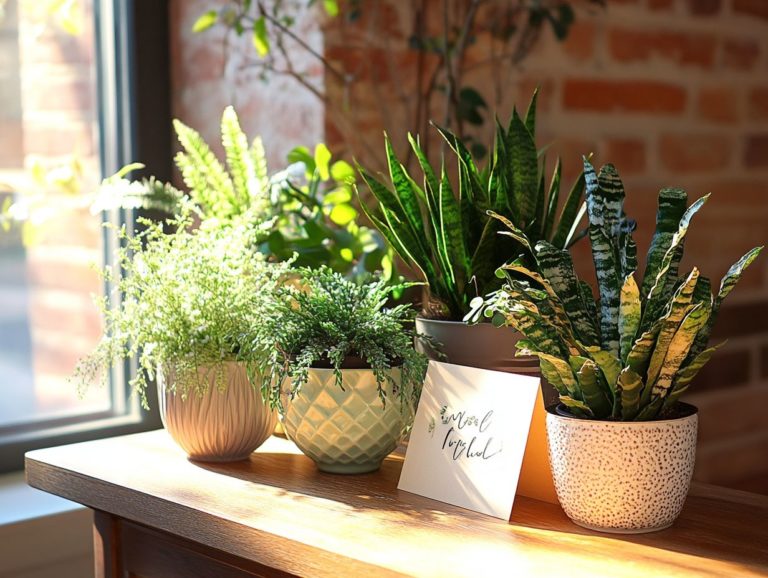How to Care for Pothos Plants at Home
Pothos plants are cherished for their lush, cascading vines and remarkable air-purifying abilities, making them a sought-after addition to both homes and offices. They are considered easy-care houseplants for beginners and seasoned plant owners alike.
If you’re eager to introduce a splash of greenery into your space or nurture your existing Pothos, you re about to discover exciting ways to enhance your space! This guide will provide you with everything you need to know from choosing the best light and temperature to mastering watering techniques, effective pruning, propagation, and essential houseplant care tips.
We ll tackle common challenges, such as plant diseases and pests like mealybugs and spider mites, and share insights to ensure your Pothos flourishes. Immerse yourself and uncover the secrets to cultivating your own indoor oasis with these resilient plants!
Contents
Key Takeaways:
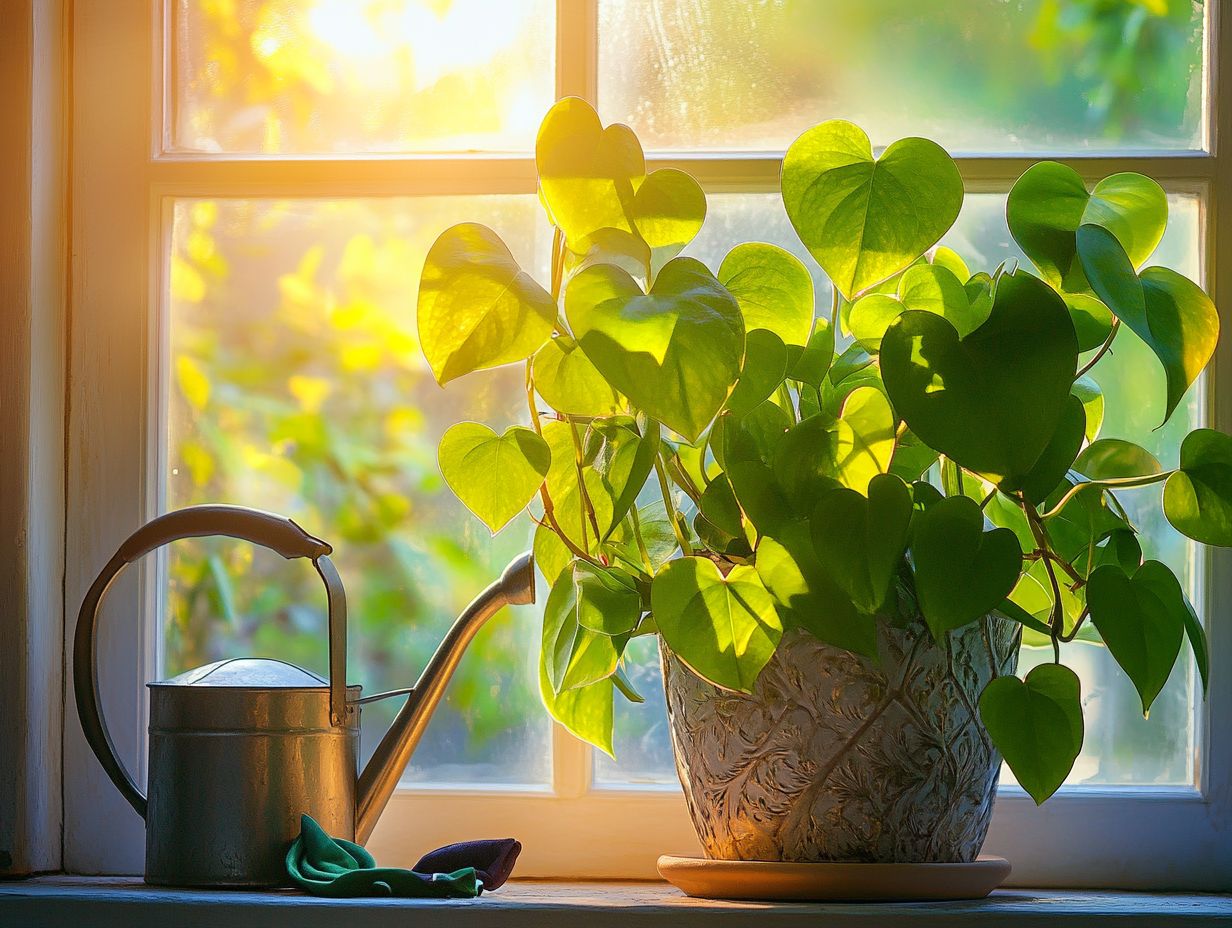
- Pick the best light and temperature for your Pothos by providing adequate light and maintaining a temperature between 65-85 F.
- Water Pothos plants correctly by allowing the soil to dry out between waterings. Fertilize them using a balanced houseplant fertilizer every 2-3 months.
- Prune and propagate Pothos plants to promote growth and keep them healthy. Watch for common problems like pests and diseases and follow proper care tips.
What is a Pothos Plant?
The Pothos plant, scientifically known as Epipremnum aureum, stands out as a premier choice for those who appreciate the art of plant care. Its stunning varieties and straightforward care requirements make it an ideal houseplant for both budding enthusiasts and seasoned gardeners alike.
Hailing from the lush landscapes of French Polynesia, this versatile vine often referred to as Golden Pothos, Devil s Ivy, or Marble Queen thrives beautifully in various indoor settings, enhancing your space with its vibrant foliage.
Its remarkable adaptability and resilience have earned it widespread acclaim, captivating anyone who values low-maintenance greenery and is interested in pothos care. Among the diverse types of Pothos, the Marble Queen is particularly celebrated for its striking white-and-green variegated leaves, while the Neon variety commands attention with its bold chartreuse hue, injecting a lively splash of color into any decor. The Pearls and Jade variant has a delightful mix of cream and dark green, creating a unique aesthetic charm.
These distinctive traits not only enhance the plant’s visual appeal but also position it as a favored choice for improving indoor air quality. This showcases the plant’s effectiveness in both aesthetics and function, especially for plant owners looking for air-purifying varieties.
Choosing the Right Environment
Choosing the perfect environment for your Pothos plant is essential to its health and vitality. This tropical vine flourishes in USDA zones 10-12, including regions like California and Florida, where the climate boasts high humidity and indirect light conditions that create an ideal haven for it to thrive.
By understanding the specific needs for light and humidity, including the importance of maintaining moist soil, you can ensure your Pothos flourishes, transforming your indoor garden into a vibrant display of greenery.
Start caring for your Pothos plants today and watch them thrive!
Light and Temperature Requirements
Pothos plants thrive in indirect light. Too much direct sunlight can scorch their leaves, while insufficient light can stunt growth. Understanding their light requirements is key to successful pothos care.
This tropical beauty prefers a warm environment. Ideally, keep them between 65 F and 85 F.
The right light helps these houseplants flourish in moist air. If humidity is low, the leaves may brown at the edges, signaling a need for adjustments in watering habits.
To help your Pothos thrive like never before, consider misting them regularly or placing a humidity tray nearby. With the right indirect light and humidity, these resilient plants can grow rapidly, showcasing their vibrant, heart-shaped leaves.
They will enhance your indoor beauty and improve air quality.
Watering and Fertilizing Pothos Plants
Proper watering and fertilizing are essential for your Pothos plants. This prevents issues like root rot.
They thrive in well-draining soil that stays moist but not waterlogged. Too much moisture can lead to root rot, a common concern for houseplant owners.
Regularly assess soil moisture and use appropriate fertilizers. This will boost the growth and vitality of your Pothos.
Your attentive care will ensure a robust and vibrant plant.
Proper Watering Techniques
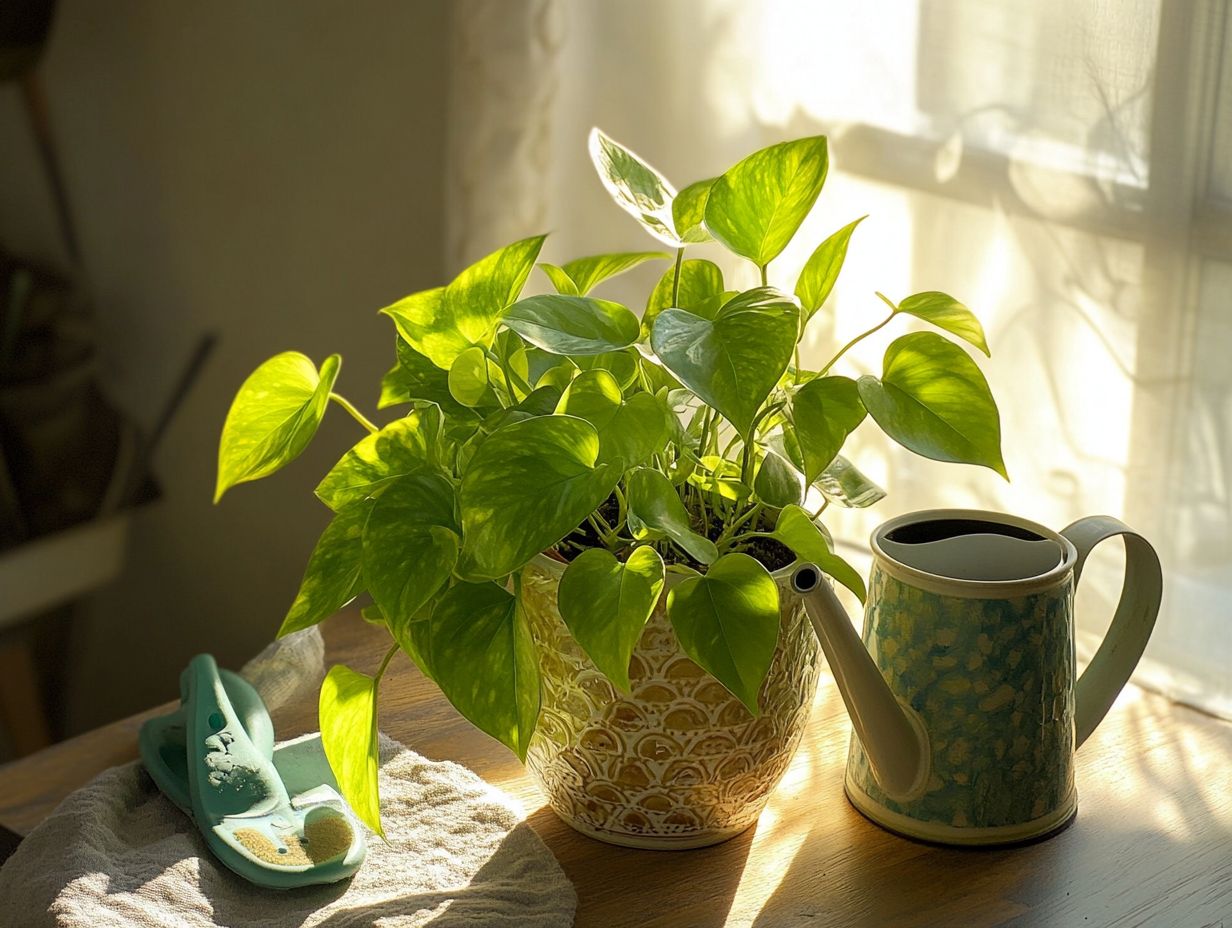
To ensure your Pothos plant thrives, master proper watering techniques. These techniques help avoid problems like root rot.
Pothos prefer their soil to be moist, never soggy. Check the soil moisture with your finger to know when to water.
Look for signs of watering issues. Overwatering can cause yellowing leaves and bad smells, while underwatering leads to curling, crispy leaves.
Choose a pot with holes for water to escape. This prevents root suffocation and keeps your pothos healthy.
Mix in perlite or orchid bark with the soil for better airflow. This supports robust growth in your Pothos varieties.
By being attentive to these signs and maintaining good watering habits, you can cultivate a healthy and robust Pothos that adds elegance to any space.
Choosing the Right Fertilizer
Choosing the right fertilizer for your Pothos plant is vital for promoting robust growth and vibrant leaves. Selecting the right houseplant fertilizer is an important aspect of Pothos care. A balanced houseplant fertilizer provides the essential nutrients your plant needs for optimal health. It helps prevent deficiencies that can affect the vitality of your Pothos.
Understanding the specific requirements of your Pothos soil will guide you in selecting the best fertilizer options and determining how often to apply them. This ensures your plants receive the necessary nutrients for successful Pothos propagation.
There are various fertilizers available, each with its own unique advantages. Organic options are particularly beneficial for houseplant care.
- Organic fertilizers, such as compost or worm castings, enhance soil structure and stimulate beneficial microorganisms.
- Synthetic options deliver nutrients more rapidly, allowing for quick absorption.
When shopping for fertilizer, take the time to read the labels carefully. Pay close attention to the N-P-K ratio, which is a number showing how much nitrogen, phosphorus, and potassium is in the fertilizer.
Timing is also key! During the growing season, typically in spring and summer, a monthly application can significantly boost growth. Less frequent feeding will suffice during dormancy.
Pruning and Propagating Pothos Plants
Pruning and propagating your Pothos plant are essential practices that elevate its health and foster fuller growth. These practices ensure your plant flourishes beautifully in your indoor oasis. They also allow you to create new plants and expand your green collection.
By regularly trimming back any leggy growth, you encourage a bushier appearance and create perfect opportunities for propagation.
This way, you can effortlessly expand your green collection, enriching your space with more vibrant life.
When and How to Prune
Understanding when and how to prune your Pothos plant is essential for maintaining its visual charm and overall vitality. Regular pruning promotes new growth and prevents overcrowding, ensuring a healthier environment for your Pothos. The best time to trim your Pothos is during the growing season, typically in spring or summer, maximizing its growth potential.
Use clean, sharp tools to minimize damage, a crucial step in proper Pothos care. Concentrate on removing yellowing or dead leaves and long, leggy stems that detract from the plant’s lush appearance. Additionally, learning simple techniques to propagate pothos can help maintain its health and vibrancy.
Aim to prune every few weeks during the active growth phase. Keep an eye on how your plant responds and adjust your technique as necessary. Refrain from cutting back more than a third of the plant at a time, as this can stress the Pothos and impede its natural development.
Propagating Pothos Plants
Propagating Pothos plants is a gratifying experience that allows you to create new greenery from existing plants. This process helps maintain a beautiful indoor landscape, particularly through techniques such as stem cuttings.
The simplest method involves taking stem cuttings with at least one node and placing them in purified water until roots develop. It’s an enjoyable gardening activity anyone can master!
This technique not only expands your collection but also serves as a beginner-friendly introduction to plant care. To get started, choose healthy stems adorned with vibrant leaves. Ensure the cut is clean to promote successful rooting.
Using purified water is wise to prevent bacterial growth. Place the cuttings in bright, indirect light to significantly enhance their chances of rooting successfully.
Change the water regularly to keep it fresh. In a few weeks, you ll see roots beginning to sprout. Once those roots reach a few inches in length, transfer your new plants to a well-draining soil mix to help them thrive.
With the right attention and care, these new Pothos plants will flourish, becoming a stunning addition to your home. Start caring for your Pothos plants today and enjoy the rewards of your efforts!
Common Pothos Plant Problems and Solutions
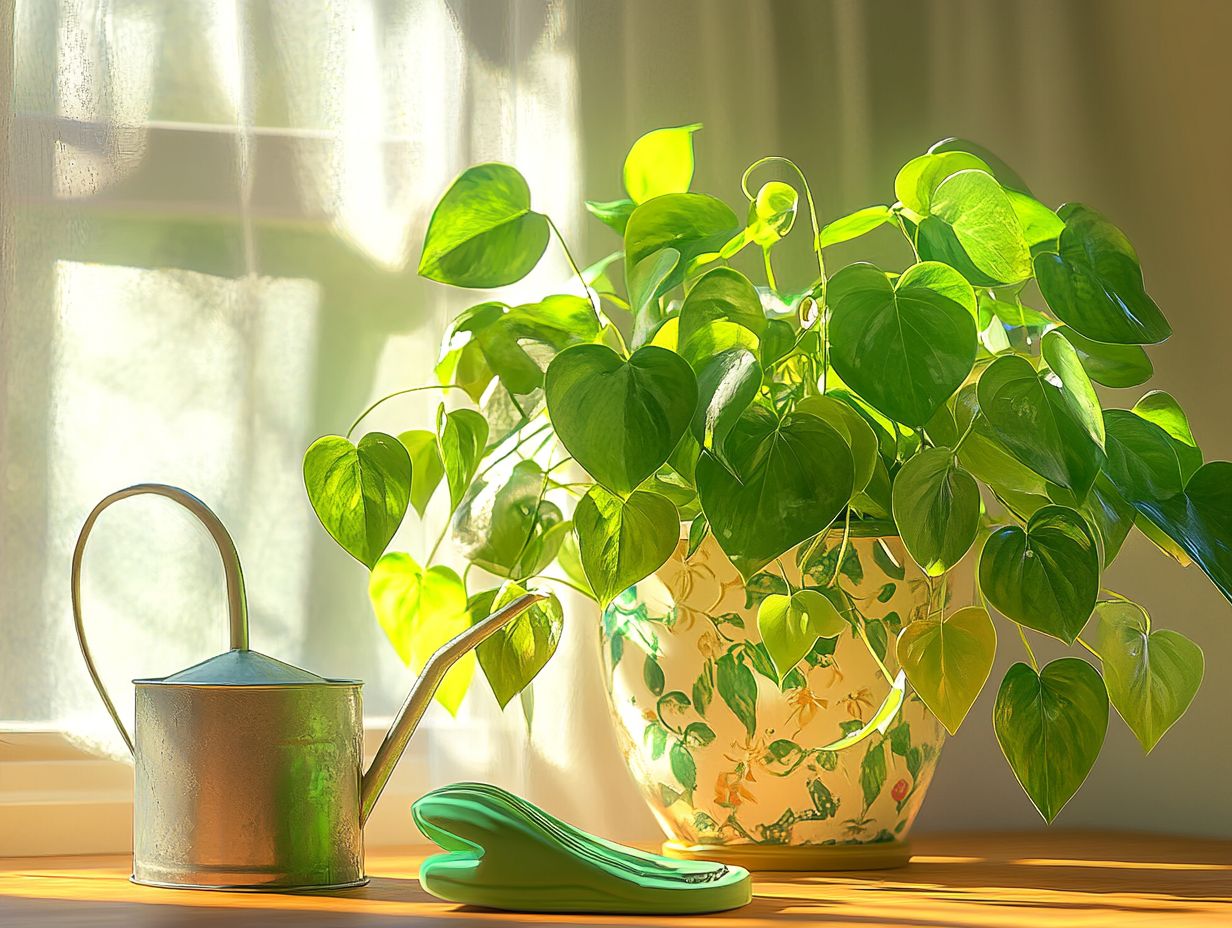
Identifying and addressing common challenges with Pothos plants is crucial for any plant owner. This species is prone to various plant diseases, pests, and even toxicity concerns if ingested by pets. Toxicity means that the plant can be harmful if eaten by pets.
Mastering the art of recognizing signs of pest infestations like mealybugs or spider mites allows for swift and effective action. This proactive approach not only safeguards the vitality of your Pothos but also preserves its stunning beauty.
Identifying and Addressing Pests and Diseases
Identifying and managing pests and diseases in your Pothos is essential for ensuring its longevity and health. Common invaders like mealybugs and spider mites can weaken your plant and cause significant damage if not managed promptly.
If you re a pet owner, understanding Pothos toxicity is crucial, as ingestion can lead to adverse effects in animals. Look for signs such as yellowing leaves, webbing, or sticky residue to quickly assess the health of your Pothos.
Early intervention is key; using insecticidal soap or neem oil can effectively combat pests. Regular monitoring is vital for identifying disease symptoms like root rot, which often shows up as blackened or mushy roots.
Ensuring proper drainage and avoiding overwatering significantly reduces the risk of fungal infections. Incorporating preventive measures, such as quarantining new plants and regularly cleaning leaves, creates a less inviting environment for pests while promoting overall plant vitality.
Essential Tips for a Thriving Pothos!
To keep your Pothos healthy and thriving, a blend of attentive care and practical houseplant tips tailored to their unique needs is essential. This includes maintaining high humidity levels and avoiding overwatering.
Following these simple tips will help your Pothos thrive! By grasping their environmental requirements, you can cultivate a lush and vibrant indoor garden that truly flourishes.
Additional Care Tips
In addition to regular watering and pruning, a few extra care tips can elevate the health and beauty of your Pothos, ensuring they remain vibrant and lush throughout their growth. Consider strategies like rotating your plant for even growth and routinely checking for pests; these simple actions will significantly help maintain its allure.
Optimal placement is key. Pothos thrive in bright, indirect sunlight yet can tolerate low-light conditions. Providing support for their trailing vines can enhance their overall appearance.
Seasonal adjustments are another savvy approach. During winter, for instance, reducing watering frequency is wise as their growth naturally slows down. Regularly inspecting the leaves allows you to catch common pests early, enabling prompt and effective treatment.
Don’t forget the power of occasional fertilization every couple of months during the growing season; this can significantly promote more robust growth and vibrant foliage.
Frequently Asked Questions
What is the best way to water a Pothos plant?
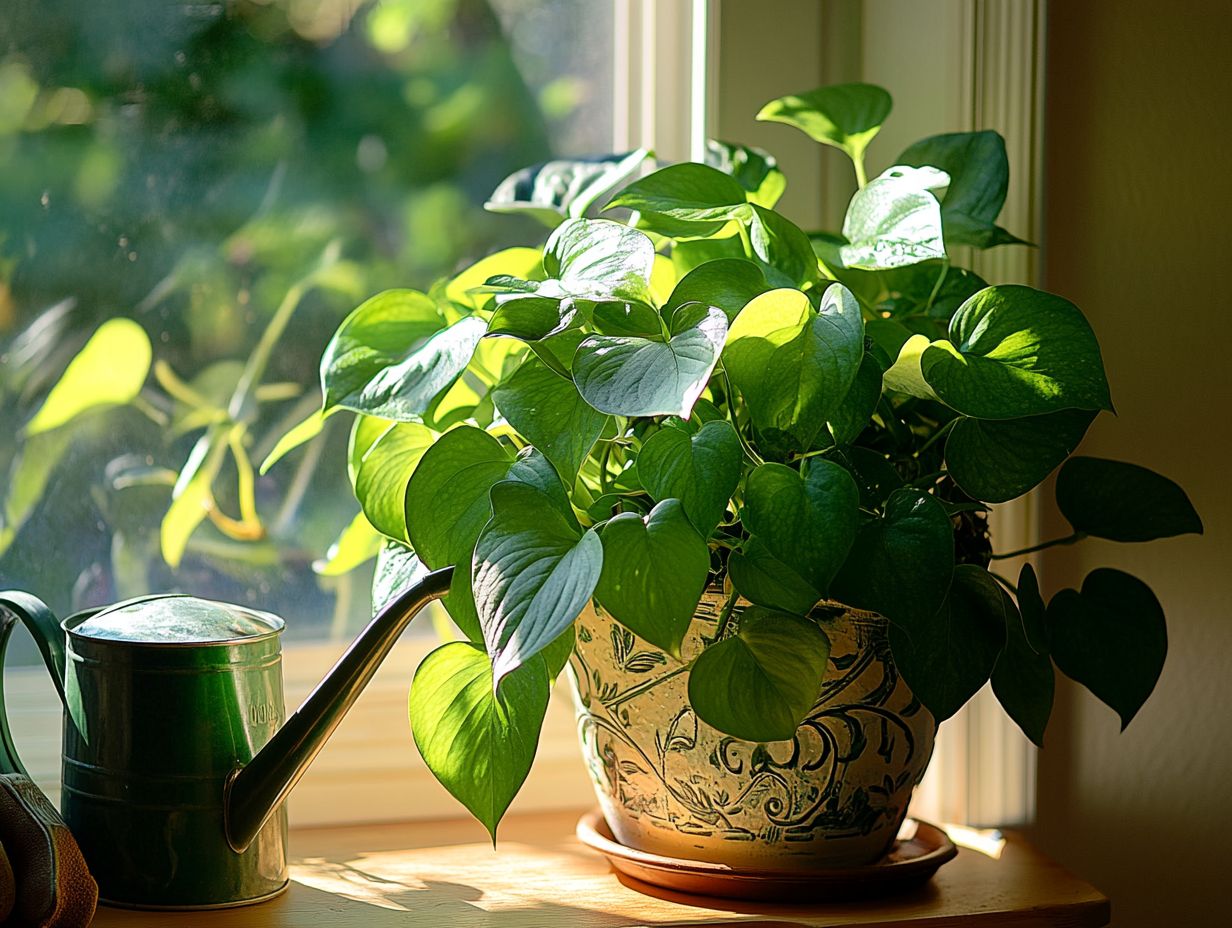
Pothos plants should be watered thoroughly when the top inch of soil is dry. This usually occurs once a week but may vary depending on temperature and humidity. Water until excess water drains out of the bottom of the pot.
How much light does a Pothos plant need?
Pothos plants thrive in bright, indirect sunlight. Direct sunlight can cause the leaves to burn, while too little light can result in leggy growth. It’s best to place your Pothos near a window that receives filtered light.
Ready to start your Pothos journey? Grab your plant today!
How often should I fertilize my pothos plant?
Pothos plants do not need frequent fertilization. However, fertilizing once a month in spring and summer can be beneficial.
Use a balanced liquid fertilizer and dilute it to half the recommended strength. Do not fertilize during the fall and winter when the plant is not actively growing.
Can I propagate my pothos plant?
Yes! Pothos plants are easy to propagate.
Cut a healthy stem just below a node. This is where the leaf meets the stem. Place the cutting in water.
Once roots have formed, transfer it to a pot with soil. Try air layering too! It’s a fun way to grow new plants right from the mother.
How can I prevent my pothos plant from getting leggy?
Leggy growth usually means your pothos isn’t getting enough light. Ensure it receives plenty of bright, indirect sunlight.
You can also pinch off the tips of the vines to encourage bushier growth. Regular pruning helps keep your pothos plant full and healthy.
Are pothos plants safe for pets?
No, pothos plants can be toxic to pets if eaten. They contain small crystals that can cause irritation in the mouth and throat.
Keep your pothos plant out of reach of curious pets! Consider switching to a pet-friendly plant option if you have furry friends in your home.


